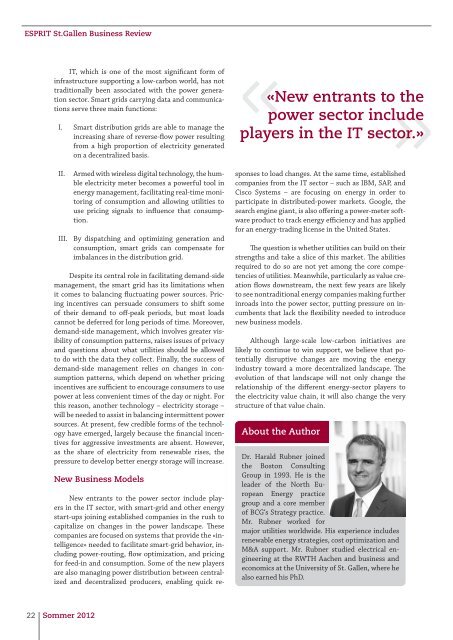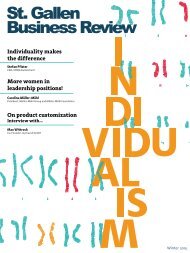Energie
St. Gallen Business Review Sommer 2012
St. Gallen Business Review
Sommer 2012
Erfolgreiche ePaper selbst erstellen
Machen Sie aus Ihren PDF Publikationen ein blätterbares Flipbook mit unserer einzigartigen Google optimierten e-Paper Software.
ESPRIT St.Gallen Business Review<br />
IT, which is one of the most significant form of<br />
infrastructure supporting a low-carbon world, has not<br />
traditionally been associated with the power generation<br />
sector. Smart grids carrying data and communications<br />
serve three main functions:<br />
I. Smart distribution grids are able to manage the<br />
increasing share of reverse-flow power resulting<br />
from a high proportion of electricity generated<br />
on a decentralized basis.<br />
II.<br />
Armed with wireless digital technology, the humble<br />
electricity meter becomes a powerful tool in<br />
energy management, facilitating real-time monitoring<br />
of consumption and allowing utilities to<br />
use pricing signals to influence that consumption.<br />
III. By dispatching and optimizing generation and<br />
consumption, smart grids can compensate for<br />
imbalances in the distribution grid.<br />
Despite its central role in facilitating demand-side<br />
management, the smart grid has its limitations when<br />
it comes to balancing fluctuating power sources. Pricing<br />
incentives can persuade consumers to shift some<br />
of their demand to off-peak periods, but most loads<br />
cannot be deferred for long periods of time. Moreover,<br />
demand-side management, which involves greater visibility<br />
of consumption patterns, raises issues of privacy<br />
and questions about what utilities should be allowed<br />
to do with the data they collect. Finally, the success of<br />
demand-side management relies on changes in consumption<br />
patterns, which depend on whether pricing<br />
incentives are sufficient to encourage consumers to use<br />
power at less convenient times of the day or night. For<br />
this reason, another technology – electricity storage –<br />
will be needed to assist in balancing intermittent power<br />
sources. At present, few credible forms of the technology<br />
have emerged, largely because the financial incentives<br />
for aggressive investments are absent. However,<br />
as the share of electricity from renewable rises, the<br />
pressure to develop better energy storage will increase.<br />
New Business Models<br />
«New entrants to the<br />
power sector include<br />
players in the IT sector.»<br />
New entrants to the power sector include players<br />
in the IT sector, with smart-grid and other energy<br />
start-ups joining established companies in the rush to<br />
capitalize on changes in the power landscape. These<br />
companies are focused on systems that provide the «intelligence»<br />
needed to facilitate smart-grid behavior, including<br />
power-routing, flow optimization, and pricing<br />
for feed-in and consumption. Some of the new players<br />
are also managing power distribution between centralized<br />
and decentralized producers, enabling quick responses<br />
to load changes. At the same time, established<br />
companies from the IT sector – such as IBM, SAP, and<br />
Cisco Systems – are focusing on energy in order to<br />
participate in distributed-power markets. Google, the<br />
search engine giant, is also offering a power-meter software<br />
product to track energy efficiency and has applied<br />
for an energy-trading license in the United States.<br />
The question is whether utilities can build on their<br />
strengths and take a slice of this market. The abilities<br />
required to do so are not yet among the core competencies<br />
of utilities. Meanwhile, particularly as value creation<br />
flows downstream, the next few years are likely<br />
to see nontraditional energy companies making further<br />
inroads into the power sector, putting pressure on incumbents<br />
that lack the flexibility needed to introduce<br />
new business models.<br />
Although large-scale low-carbon initiatives are<br />
likely to continue to win support, we believe that potentially<br />
disruptive changes are moving the energy<br />
industry toward a more decentralized landscape. The<br />
evolution of that landscape will not only change the<br />
relationship of the different energy-sector players to<br />
the electricity value chain, it will also change the very<br />
structure of that value chain.<br />
About the Author<br />
Dr. Harald Rubner joined<br />
the Boston Consulting<br />
Group in 1993. He is the<br />
leader of the North European<br />
Energy practice<br />
group and a core member<br />
of BCG‘s Strategy practice.<br />
Mr. Rubner worked for<br />
major utilities worldwide. His experience includes<br />
renewable energy strategies, cost optimization and<br />
M&A support. Mr. Rubner studied electrical engineering<br />
at the RWTH Aachen and business and<br />
economics at the University of St. Gallen, where he<br />
also earned his PhD.<br />
22<br />
Sommer 2012


















